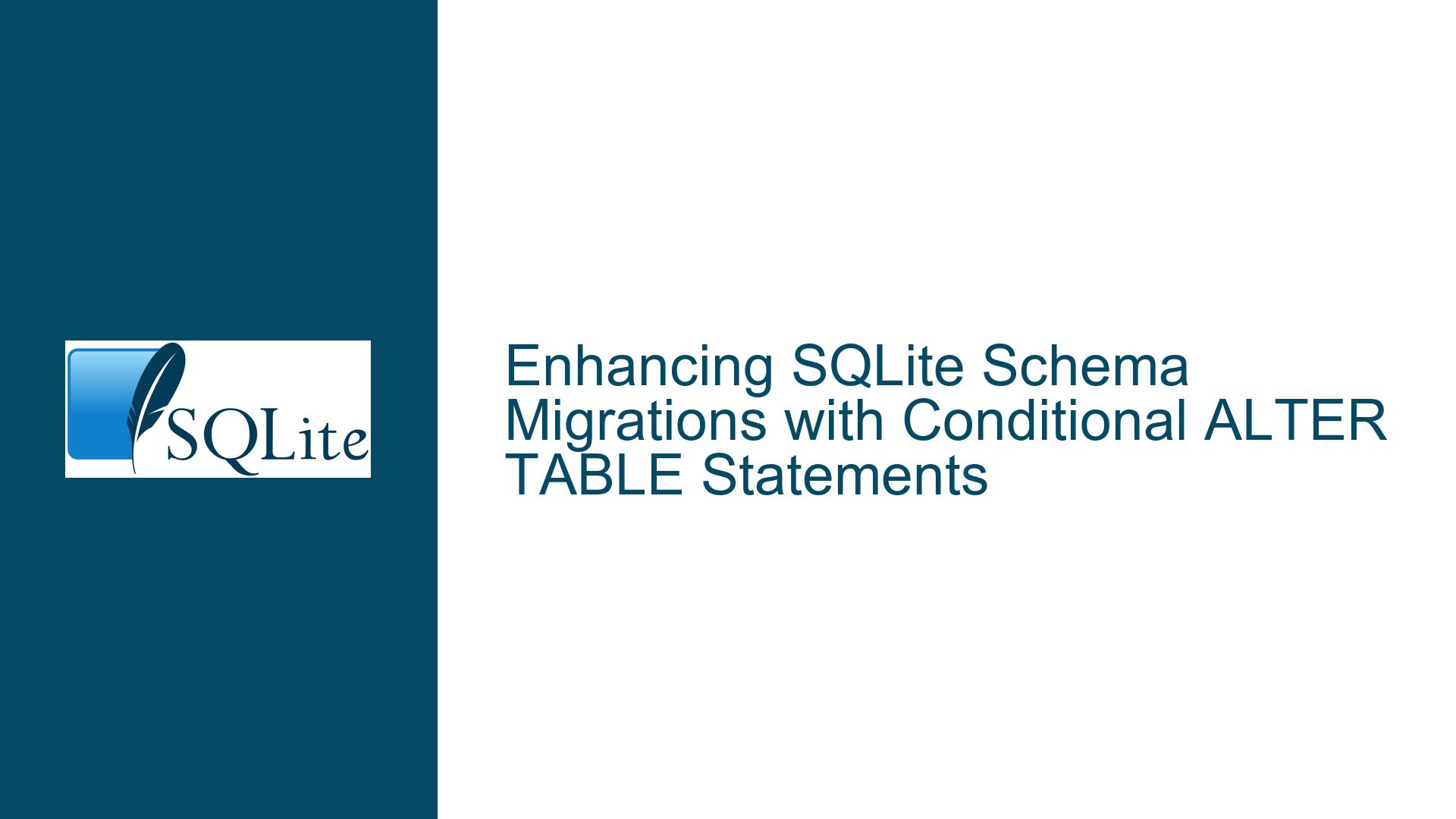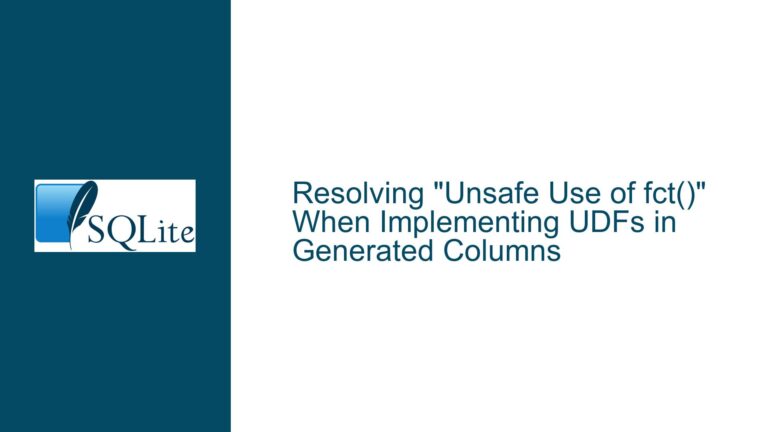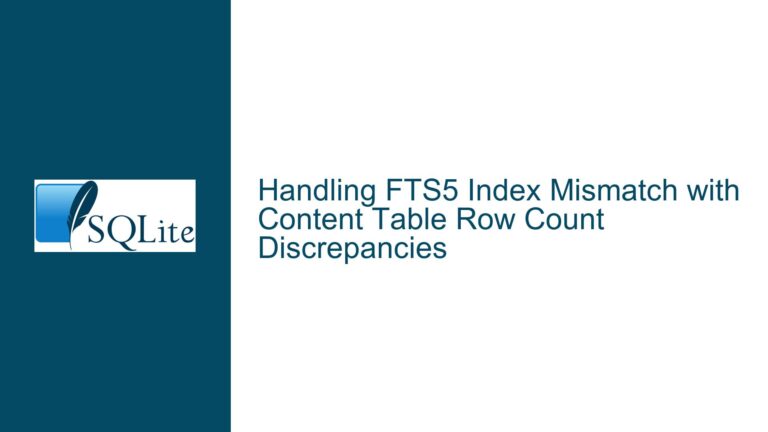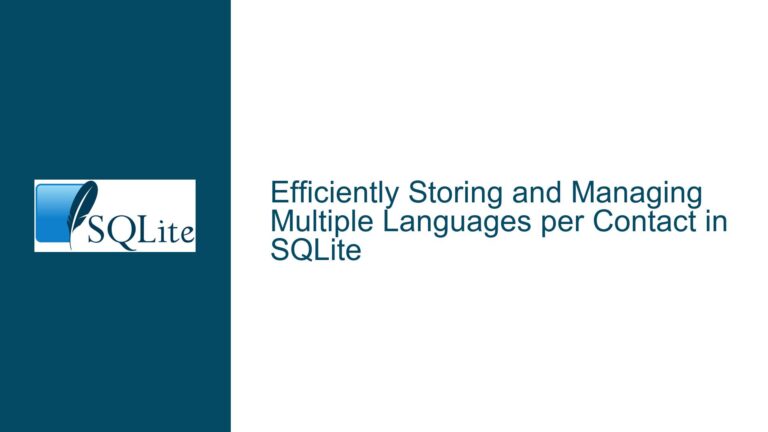Enhancing SQLite Schema Migrations with Conditional ALTER TABLE Statements
The Need for Conditional ALTER TABLE Statements in SQLite Schema Migrations
Schema migrations are a critical aspect of database management, especially in production environments where changes to the database structure must be applied without disrupting existing operations. SQLite, being a lightweight and widely-used database engine, provides robust support for schema modifications through its ALTER TABLE statement. However, one limitation that has been a point of discussion among developers is the lack of conditional clauses in ALTER TABLE statements, such as IF NOT EXISTS for adding columns or IF EXISTS for dropping columns. This limitation complicates the process of writing idempotent schema migration scripts, which can be safely applied multiple times without causing errors.
The absence of these conditional clauses means that developers must either write additional application-level logic to handle potential errors or execute schema changes one statement at a time with error handling. This approach is not only inelegant but also increases the complexity of migration scripts, making them harder to maintain and more prone to errors. The discussion in the provided forum thread highlights the desire for SQLite to support conditional ALTER TABLE statements, similar to what is available in other database systems like PostgreSQL. This enhancement would allow developers to write more concise and reliable schema migration scripts, reducing the risk of errors and simplifying the migration process.
Challenges in Implementing Conditional ALTER TABLE Statements
Implementing conditional clauses in ALTER TABLE statements presents several challenges, both from a technical and a design perspective. One of the primary technical challenges is determining the appropriate conditions under which a schema change should proceed. For example, when adding a column with the IF NOT EXISTS clause, SQLite must first check whether the column already exists in the table. This requires querying the internal schema representation, which can be computationally expensive, especially for large databases with complex schemas.
Another challenge is ensuring that the conditional clauses are consistent with SQLite’s existing syntax and behavior. For instance, the RENAME variation of ALTER TABLE introduces ambiguity regarding whether the IF EXISTS clause should refer to the old column name or the new column name. This ambiguity must be resolved to ensure that the syntax is intuitive and easy to use. Additionally, the implementation must handle edge cases, such as when the table or column being modified is part of a complex schema with dependencies, such as foreign keys or generated columns.
From a design perspective, the addition of conditional clauses must align with SQLite’s philosophy of simplicity and minimalism. SQLite is designed to be a lightweight and easy-to-use database engine, and any new features must not compromise these principles. This means that the implementation of conditional ALTER TABLE statements must be efficient, both in terms of performance and resource usage, and should not introduce unnecessary complexity into the SQLite codebase.
Best Practices for Handling Schema Migrations in SQLite Without Conditional ALTER TABLE
While the addition of conditional ALTER TABLE statements would simplify schema migrations in SQLite, there are several best practices that developers can follow to manage schema changes effectively in the absence of these features. One common approach is to use a versioning system to track the current state of the database schema. This involves storing a schema version number in the database and updating it whenever a schema change is applied. By checking the schema version before applying a migration, developers can ensure that each change is applied only once, avoiding errors caused by attempting to apply the same change multiple times.
Another best practice is to use transactions to ensure that schema changes are applied atomically. SQLite supports transactional schema changes, meaning that multiple schema modifications can be grouped into a single transaction. If any part of the transaction fails, the entire transaction can be rolled back, ensuring that the database remains in a consistent state. This approach is particularly useful when applying complex schema changes that involve multiple steps, such as adding or dropping multiple columns or tables.
Developers can also use application-level logic to handle conditional schema changes. For example, before attempting to add a column, the application can query the database schema to check whether the column already exists. If the column does not exist, the application can then proceed with the ALTER TABLE statement. While this approach requires additional code, it provides a way to achieve idempotent schema migrations without relying on conditional ALTER TABLE statements.
In cases where the schema changes are particularly complex or involve dependencies, such as foreign keys or generated columns, developers may need to use more advanced techniques, such as creating a new table with the desired schema and copying data from the old table to the new one. This approach can be more time-consuming and resource-intensive, but it ensures that the schema changes are applied correctly and that the database remains consistent.
Conclusion
The discussion around conditional ALTER TABLE statements in SQLite highlights the challenges and opportunities associated with schema migrations in a lightweight database engine. While SQLite currently lacks support for conditional clauses in ALTER TABLE statements, developers can use a combination of versioning, transactions, and application-level logic to manage schema changes effectively. The addition of conditional ALTER TABLE statements would simplify the process of writing idempotent schema migration scripts, reducing the risk of errors and making it easier to maintain and update database schemas in production environments. As SQLite continues to evolve, it is likely that these features will be considered for future releases, further enhancing the database engine’s capabilities and ease of use.






